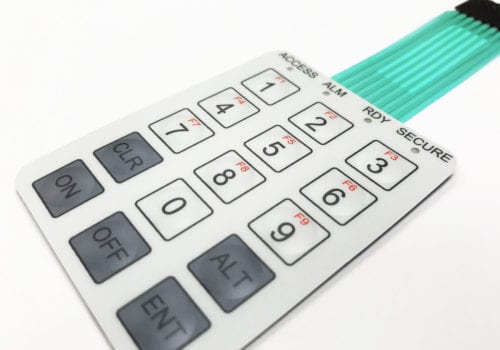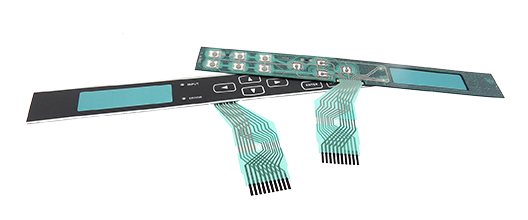Discover the Future of Control Interfaces: Why Membrane Layer Changes Are Gaining Popularity
As industries progressively prioritize user-friendly and efficient control user interfaces, membrane switches are emerging as an engaging option that integrates capability with style versatility. With the surge of smart modern technology and sustainability worries, the innovations and capacities surrounding membrane layer changes warrant more detailed evaluation.
Recognizing Membrane Switches
Membrane switches are indispensable parts in modern-day electronic gadgets, acting as interfaces between equipments and users. These buttons contain numerous layers, generally consisting of a graphic overlay, a spacer layer, and a circuit layer. When a user presses a switch on the overlay, the top layer reaches the circuit layer, finishing a circuit and sending a signal to the device. This straightforward yet reliable mechanism permits smooth communication with innovation.

Longevity is one more key attribute, as membrane layer switches can be created to resist ecological aspects such as moisture, dust, and chemicals. This durability makes them ideal for applications in harsh conditions. On the whole, recognizing the framework and feature of membrane layer switches is important for valuing their role in the development of user interfaces in today's technology-driven world.
Trick Benefits of Membrane Layer Buttons
Offering a series of advantages, membrane layer buttons have actually come to be a recommended option in numerous applications (Membrane Switches). Among the primary benefits is their small style, enabling suppliers to maximize area in gadgets without compromising capability. Membrane buttons are light-weight, which is especially valuable in portable digital gadgets

Furthermore, these buttons give exceptional toughness. Constructed from adaptable products, they are resistant to dust, dampness, and a variety of ecological aspects, making them ideal for rough problems. This resilience usually converts into a much longer lifespan contrasted to typical mechanical buttons.
Additionally, membrane layer switches permit seamless integration of graphics and icons, using visual flexibility and improving individual experience. Modification options are substantial, enabling brand names to create one-of-a-kind interfaces that straighten with their item identity.
Another secret advantage is their simplicity of cleaning and maintenance. The flat surface area of membrane switches over avoids the buildup of dirt and grime, making them excellent for sanitary atmospheres. Lastly, membrane layer switches are cost-efficient, as they can be created in high volumes at reduced expenses, making them easily accessible for a vast range of sectors. These elements jointly add to their increasing appeal in modern-day control interfaces.
Applications Across Industries

A myriad of sectors are increasingly embracing membrane layer buttons because of their convenience and functionality. These manage user interfaces are particularly prevalent in the automotive industry, where they are utilized in control panels and infotainment systems, offering a user-friendly and smooth interface. In the clinical field, membrane layer switches over assist in the procedure of diagnostic equipment and client surveillance systems, making sure integrity and ease of usage in important situations.
In addition, the customer electronic devices industry gain from membrane layer switches in tools such as microwaves and remote controls, permitting structured design and boosted toughness. Membrane Switches. The aerospace industry likewise uses membrane buttons in cockpit controls, where area constraints require efficient and compact style services
Furthermore, the industrial sector utilizes membrane layer buttons in machinery control panels, supplying durability versus rough environments and ensuring functional efficiency. Retail settings have actually embraced membrane buttons in point-of-sale systems, enhancing user interaction while keeping aesthetic charm.
Layout Trends in Membrane Layer Switches
Advancing together with technological improvements, design trends in membrane layer buttons are increasingly concentrated on enhancing user experience and visual appeal. Modern membrane switches are being made for simplicity and user-friendly use, enabling customers to navigate user interfaces effortlessly. This change towards user-centric design stresses responsive feedback, guaranteeing that individuals obtain instant verification of their activities.
In addition, adjustable graphics and colors are becoming conventional attributes in membrane button designs. This versatility permits suppliers to produce tailored interfaces that align with branding and certain individual needs. The unification of backlighting is reference one more popular fad, as it not only improves presence in low-light conditions yet additionally adds an aesthetically striking element to the general style.
This shift not just enhances aesthetics however additionally adds to the total performance and resilience of the switches. These layout trends collectively emphasize the growing value of combining form and function in the growth of membrane buttons, inevitably enhancing the user experience.
Future Expectation for Control Interfaces
The future of control user interfaces is poised for significant improvement as arising technologies remain to reshape user interactions across various gadgets. The assimilation of advanced materials, such as conductive inks and adaptable electronic devices, will boost the flexibility and capability of membrane switches, making them significantly adaptable to a series of applications. Additionally, the rise of the Internet of Points (IoT) will certainly drive demand for more user-friendly, user-friendly user interfaces that can effortlessly integrate with wise tools.
As expert system and maker discovering advance, control user interfaces will likely incorporate even more customized attributes, permitting users to connect with tools in methods that are customized to their habits and choices (Membrane Switches). This change towards user-centric style will certainly position membrane layer buttons as a principal in the marketplace, specifically in sectors like health care, automobile, and customer electronics
Additionally, the push for sustainability will motivate producers to check out environmentally friendly materials and production methods, ensuring that the future of control user interfaces lines up with ecological considerations. Overall, as technology continues to advance, membrane layer buttons will certainly become increasingly sophisticated, leading the way for innovative control options that enhance individual experience and functional performance throughout varied industries.
Conclusion
In conclusion, the raising fostering of membrane switches over highlights their significance in the development of control interfaces. As straightforward user interfaces end up being important in the context of IoT and AI innovations, membrane layer buttons are positioned to play a vital role.
As markets increasingly this article focus on easy to use and effective control interfaces, membrane switches are emerging as an engaging service that incorporates functionality with style flexibility.Longevity is another vital function, as membrane buttons can be developed to stand up to environmental variables such as moisture, dirt, and chemicals.Evolving alongside technical advancements, design trends in membrane layer buttons are progressively focused on boosting customer experience and aesthetic appeal. Modern membrane switches are being developed for simplicity and intuitive use, enabling individuals Our site to navigate user interfaces easily. These style patterns collectively highlight the growing significance of incorporating form and function in the growth of membrane layer buttons, ultimately enriching the user experience.